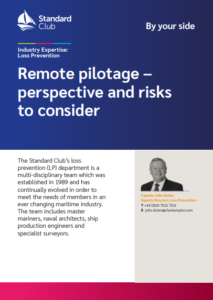Remote piloting allows qualified pilots, situated on land or on a pilot boat, to guide the vessel remotely. Now, Captain John Dolan, Deputy Director of Loss Prevention, The Standard P&I Club, acknowledges the risk factors that should be carefully considered before the practise of remote pilotage is undertaken, and shares club concerns and recommendations.
Accordingly, it is stated that the pilotage should be limited to taking the ship from the port’s usual pilot boarding position to the customary anchorage where vessels wait for their berths.
The Club notes that
We would not recommend remote pilotage for berthing or unberthing or connecting tugs during the transit.
Moreover, passage plan is a major part. Therefore, the Club provides a list of some of the principal risk factors that should be considered carefully before such an operation is undertaken.
Accordingly:
- The pilotage area. How complex is it, for example, is it an open sea anchorage, a river passage, etc?
- The master’s familiarity of the port/area. Is this the first time that the master has called at the port? If so, greater caution is required and the member should act prudently, perhaps by avoiding the remote pilotage altogether
- Time of day. Such a pilotage should, in the club’s view, only be undertaken in daylight.
- Size of the vessel. A large vessel relative to the width/ depth of the approach channel will present an elevated risk of grounding due to unexpected dynamic forces acting on the hull.
- The passage plan is effectively the practical application of the risk assessment process. It should identify all the attendant hazards and state the mitigating factors to reduce the associated risks. These factors will include the minimum under keel clearance required, detailed port approaches information including reporting points, ‘choke’ locations in the channel, highlighted tidal/ current information and any navigation warnings concerning navigation buoys and their light and sound characteristics.
In addition, the Club recommends that the operation is only conducted when it is enforced by port regulations or in extreme emergency situations and, even then, we would limit the passage to the period between the pilot station and the customary anchorage for the port.
We would not recommend remote pilotage when the ship is berthing or unberthing. These operations require the presence and advice of an experienced pilot who has extensive local knowledge and who is usually assisted by port tugs.
To learn more click herebelow































































